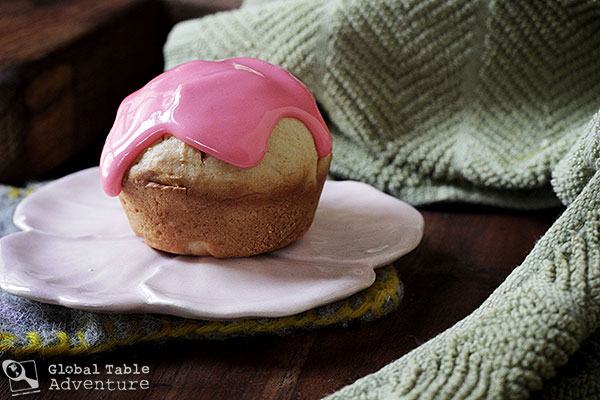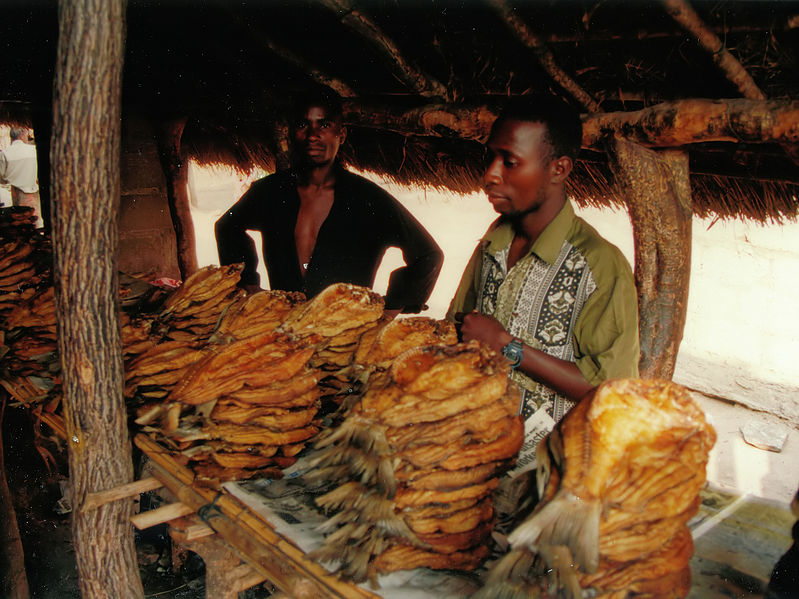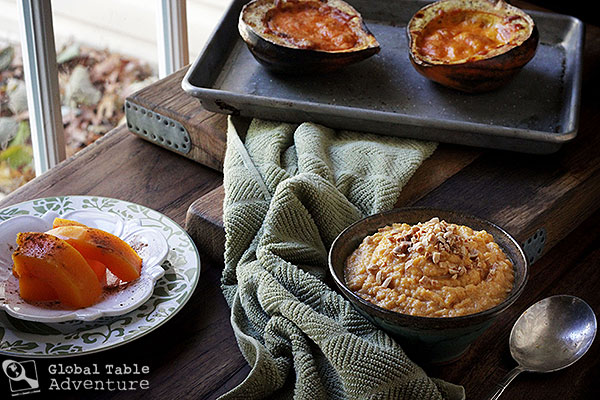
Everywhere I go, I see the rust, orange, and gold of pumpkins and squashes. Some smile from my neighbors’ front stoops. Some have been tagged for this year’s Thanksgiving pie or pumpkin pancakes (Hello, Russia!). Even Pinterest looks like a digital pumpkin patch of late. All this for good reason. These beautiful gourds are autumn. They represent breathless hikes to pick out the biggest, the gnarliest, the cutest in the bunch. But for all that, I can only look at so many pumpkin recipes before my eyes glaze over. Until Zimbabwe. In this southern African country, gourds are served up in fun and fresh ways. In my wildest dreams I never considered putting peanut butter with butternut squash. But my goodness… it works! Here are three recipes from Zimbabwe to add interest to your global fall fest. 1. Roasted Acorn Squash with Cheddar & Corn Oh man, oh man, oh man. Seriously. I’d be proud to call this lunch any time of day. This recipe was originally made with a “gem” squash in Zimbabwe, which I can’t obtain in Oklahoma. …
Read More

I don’t think I’ve ever done this. I’ve always told you the menu. Every Wednesday for 195 weeks, my choices have been in this space, recorded in black and white. But today… I’m just not ready to tell you what I’m making. Perhaps it’s panic. What if I make the wrong choice this week? Or perhaps it’s denial. What if I’m not ready for it to be over? I can tell you this much: there will be pumpkins and squashes. There will be peanuts and peanut butter. And there will be, I assure you, some kind of dessert. Because I just don’t know how to celebrate the ending without a little something sweet. So, bear with me, friends… The first recipe will be up tomorrow. UPDATE: 3 Quick Recipes for Zimbabwean Pumpkin and Squash [Recipe] Three amazing recipes: 1) Acorn squash roasted with corn and cheese 2) Peanut Butter Butternut Squash 3) Cinnamon Pumpkin Zimbabwe Candy Cake | Chikenduza [Recipe] A dense, yeasty cake with sweet icing. A favorite in Zimbabwe’s city bakeries. And here’s a proverb …
Read More

Yesterday, I mentioned my fear of crossing “the chasm”, towards the final post of this Adventure. And yet, here we are. Time stalls for none. This is the first step over Victoria Falls from Zambia to Zimbabwe. There are a few restaurants near the falls, like the Rainforest Cafe, where you can get a Crocodile Tail Wrap with wasabi. Talk about fusion! As one travels further into the heart of this southern African country, more traditional foods appear, like pumpkin greens (bowara) cooked with peanut butter, peanut butter stews, and even pumpkin and peanut butter. (Here are three recipes for pumpkin and squash enjoyed in Zimbabwe) Not enough peanut butter for you? Next time you boil up rice (white or brown), stir in a few spoonfuls of peanut butter – just enough so that you can shape the rice into balls. This is called Mupunga une dovi. Serve your meal with anything from the tradtional sadza (a maize-based, stiff porridge), to the cities’ sweet buns made with yeast and sugar. Many foods you might recognize from …
Read More

Between Zambia and Zimbabwe lies the stunning chasm of mist and water called Victoria Falls. The water flows through both countries like some stealthy border walker, never fixed to one particular country. Never tied down. In this poetic space, where rapids, danger, and sparkling, spraying joy all tumble together, I see meaning for our own little cooking adventure. I’m on one side of the end, metaphorically sitting in Zambia, looking at Zimbabwe. Wondering what comes next. I’m so close to reaching my goal of eating every country in the world. So. Close. And yet, the “end” feels so, so, so far away. Almost unattainable. By this, I don’t really mean the cooking . Cooking one more country will be easy. I know how to research recipes. I know how to cook them. Sure, I make mistakes from time to time, but after four years, the process feels like breathing. No. It’s something else that feels far away, that feels unattainable. Perhaps it’s that I don’t know how to reach a goal of this magnitude. Not …
Read More
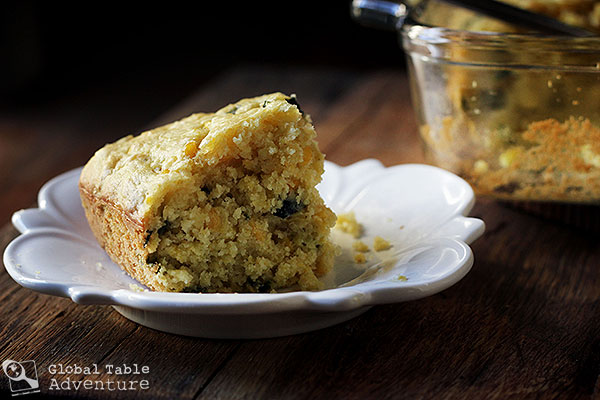
If you ask my husband, there’s always room for cornbread. And he’ll eat twice as much cornbread if green chilies dot through the crumb. But what would he think if the cornbread came from half a world away? If it came from Zambia? As a former “Mr Picky” he says: Mealie Bread is a good way to bridge the gap for picky eaters to try something from another culture. The cornbread in Zambia is much like the cornbread in the USA – except it is made with fresh corn kernels instead of cornmeal. This makes the flavor come alive. Zambians call it mealie bread (mealie is just another name for corn; mealie bread is popular all over southern Africa). The result is moist (bordering on juicy), naturally sweet, and great on the side of any autumn stew (such as Zambia’s Spiced Tilapian Stew). If you’re lucky enough to slice into the mealie bread while it’s still hot? Well… forget about having leftovers. So why stud the mealie bread with chilies? Because Zambians love chili peppers. Chilies are available in the …
Read More
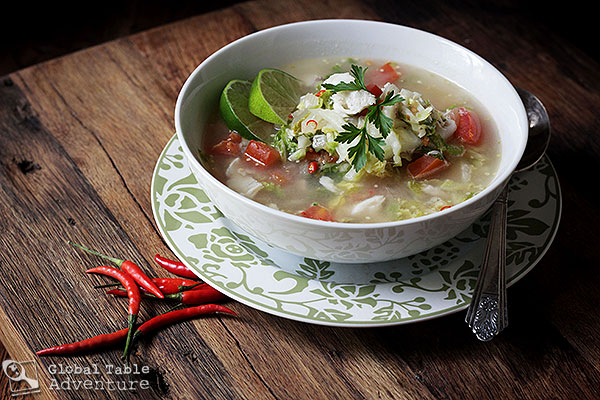
“Leading a race does not mean that you will win it.” Zambian Proverb It’s a chilly, wintery, blustery sort of day. Even the trees shudder, their leaves falling down in chatterings. Thankfully, Zambia makes quick work of dissipating the cold, with this Spiced Tilapia Stew. Each bite pops with fresh lime juice, tomatoes, and Napa cabbage. A dusting of cumin, mustard seeds, fresh ginger and garlic give the broth depth. But it’s the Thai Bird chilies that’ll clear your sinuses. Even just one in the pot promises a mellow tingle in every spoonful. This is another kind of DIY soup, because of the garnishes. Children will especially enjoy squeezing lime juice on their soup and sprinkling their bowl with parsley. Adults will enjoy seeing how many Thai Bird chili peppers they can handle. My husband added an entire sliced chili to his bowl; though he was sniffling and coughing from the heat, he then proceeded to add more. A note on the Tilapia: traditional Zambian stews often use dried tilapia. We’ve used fresh because …
Read More
“Talk to a person who can understand and cook for a person who can be satisfied.” Zambian Proverb I’m in the final phases of writing my memoir. By the end of November, the manuscript will be sent off to National Geographic to do their magic. At that point, they’ll work on final edits, layout, and publicity. And then, boom, next year there will be a book. My book. It’s the story of my search for food, family, and home – and I can’t wait to share it with you. But right now, I’m in crunch time and the Zambian proverb above really spoke to me because, with my book, I’ll be talking to you and cooking for you. I’ll be telling you the story of my life, and the recipes that carried me through troubling times. Hopefully, as the proverb reads, you’ll understand and be satisfied! These recipes and the meal review will be posted throughout the week. Spiced Tilapia Stew [Recipe] Typically made with dried tilapia, our version uses more readily available fresh fish, …
Read More
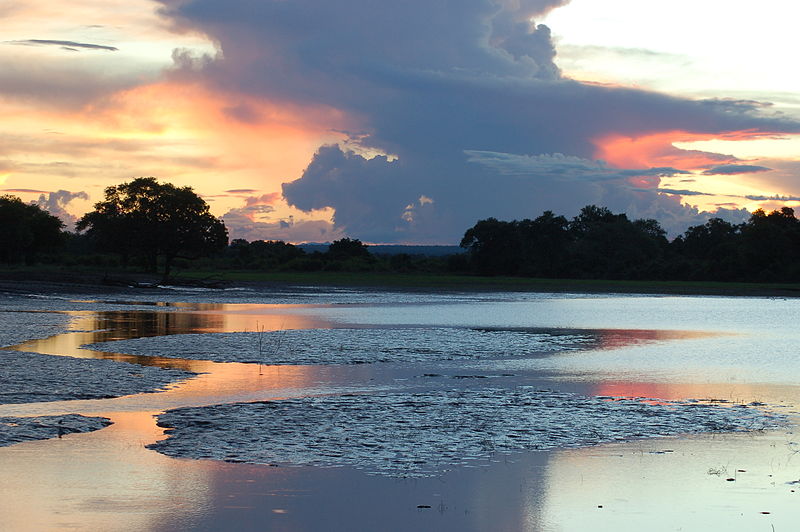
While you’ll find caterpillars and grasshoppers on the menu on the tropical plateaus of Zambia, maize (a.k.a. sweet corn) is far more common. This southern African nation will enjoy maize as a stiff porridge called nshima, in a beer called chibuku, and in sweet loafs (similar to our cornbread, but made with fresh corn [Recipe]). Like many African countries, the groundnut (a.k.a. peanut) is beloved, especially when stirred into stewed greens. Peanut oil is also preferred by many Zambian families, as for when they fry up a batch of sliced plantains. There’s also the peanut sausage. According to the World Cookbook for Students: A vegetarian “sausage” named after the wild orchid tubers called chinaka or chikanda (depending on the ethic group) used to gel them. Amazing. Fishing has a big influence on the diet of Zambians who live near the many lakes, and it is often salted and dried for preservation or travel over long distances. The salted fish is later used in stews and soups, perhaps with a few onions and tomatoes [Recipe]. Much of the population …
Read More

“It is better that trials come to you in the beginning and you find peace afterwards than that they come to you at the end.” Proverb from Uganda I spent our Ugandan meal talking about one thing, and one thing alone: our Global Table Experience event on October 12th. We’re attempting to put a dish from as many countries as possible on a stretch of tables at Philbrook Museum of Art in Tulsa, Oklahoma. The goal? 196. Gulp. I’m officially one of those people – so obsessed and focused on this amazing feat, that I can literally think of nothing else. My poor neighbor was focused on figuring out the lemon, rosemary, peanut oil, and harissa on his kebab, but I kept blabbing about the event. I sleep, eat, and dream about how on earth we are going to achieve our goal of putting a dish from every country in the world on a single stretch of tables. Oh boy, oh boy, oh boy. Even if we get halfway there, what a feat! Especially considered all this food will be offered to the public – that’s you – for …
Read More
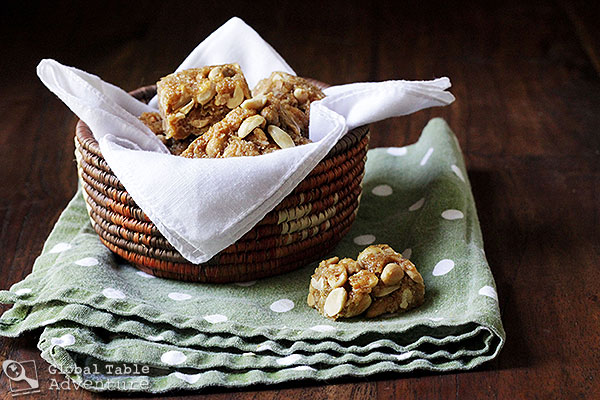
On the simmering streets of Uganda, you can walk up to a street vendor and satisfy your sweet tooth with a big bite of Kashata. Loosely speaking, Kashata is East African brittle. It’s most popular in Uganda and Tanzania. It’s hard, sweet, and all kinds of delicious. I’ve seen Kashata shaped as cubes, balls, and diamonds. Some are flat, some are thick. Just like people, the shape doesn’t matter; it’s all about what’s on the inside. The most glorious Kashata are a blend of peanuts, shredded coconut, and either cinnamon or cardamom. You can also find Kashata made from all coconut or all peanuts. Moreover, sometimes you simply dump in whatever nuts you have on hand. Easy. Makes enough to share. 1-2 dozen (depending on how thin you spread the mixture) Ingredients: 2 cups sugar 1 1/2 – 2 cups peanuts 1 1/2 – 2 cups dried coconut (unsweet) 3/4 tsp ground cardamom (or cinnamon) pinch salt oil, for greasing Method: Let’s go to Uganda, where electricity is optional… because, truth be told, this entire …
Read More
Summer still catwalks through the August air, unabashed and sizzling. There’s still time to grill, still time to sit out under the stars without a coat, or even a hoodie. There’s time to wear out those flipflops and kick back in sunglasses. And there’s still time to try Uganda’s kebabs, adapted from Marcus Samuelsson’s beautiful cookbook Discovery Of A Continent – Foods, Flavors, And Inspirations From Africa. The flavors are intense. Bright lemon juice starts of the explosion. A long marinade brings out bright sparks from the citrus. Then there’s a needling burn from the Harissa, a traditional spice often found in North African cooking. How much heat is there? As much as you can handle. Or as little as you’d like. Tip: You find Harissa mix at Whole Foods in the spice aisle (to be combined with water, olive oil, and crushed garlic), or you can buy a canned paste at a Middle Eastern market. Be sure to add this to taste, as some mixes may be spicier than others. IF you use the …
Read More

